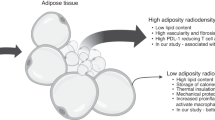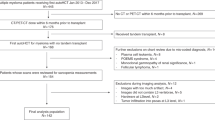Abstract
Modern treatment strategies have increased life expectancy in multiple myeloma, but little is known about the endocrine, metabolic and nutritional status of long-term survivors. We performed endocrine, metabolic, bone, body composition and nutritional evaluations in 32 patients with intensively-treated, advanced but stable, myeloma a median duration of 6 years from diagnosis and three lines of intensive treatment, including at least one haematopoietic SCT procedure. All patients were off active treatment. There was a high prevalence of endocrine dysfunction: hypothyroidism (9%), hypogonadism (65% males) and elevated prolactin (19%). Adrenocortical function was preserved despite large cumulative corticosteroid pretreatment. Biochemical markers were consistent with postmenopausal status in all females and infertility in males. Nutritionally, 59% were vitamin D insufficient/deficient, reduced serum folate in 25% and vitamin B12 in 6%. Total body DEXA scanning confirmed ‘sarcopenic-obesity’ in 65%, but reduced bone density was seen in a minority. We conclude that potentially correctable endocrine, metabolic and nutritional abnormalities are prevalent in heavily-treated patients with stable multiple myeloma. Preservation of bone supports the efficacy of bisphosphonate treatment from diagnosis, but sarcopenic-obesity may contribute to frailty. Ultimately, multi-system screening and appropriate interventions may optimise quality of long-term survival and further studies are warranted.
This is a preview of subscription content, access via your institution
Access options
Subscribe to this journal
Receive 12 print issues and online access
$259.00 per year
only $21.58 per issue
Buy this article
- Purchase on Springer Link
- Instant access to full article PDF
Prices may be subject to local taxes which are calculated during checkout
Similar content being viewed by others
Change history
02 July 2014
This article has been corrected since Online Publication and a corrigendum has also been published.
References
Bird JM, Owen RG, D’Sa S, Snowden JA, Pratt G, Ashcroft J et al. Guidelines for the diagnosis and management of multiple myeloma 2011. Br J Haematol 2011; 154: 32–75.
Snowden JA, Ahmedzai SH, Ashcroft J, D’Sa S, Littlewood T, Low E et al. Guidelines for supportive care in multiple myeloma 2011. Br J Haematology 2011; 154: 76–103.
Klepin HD, Hurd DD . Autologous transplantation in elderly patients with multiple myeloma: are we asking the right questions? Bone Marrow Transplant 2006; 38: 585–592.
National Institutes of Health. Late effects definition. In National Cancer Institute Dictionary of Cancer Terms http://www.cancer.gov/dictionary?cdrid=390292 Accessed 30 January 2014.
Vermeulen A, Verdonck L, Kaufman JM . A critical evaluation of simple methods for the estimation of free testosterone in serum. J Clin Endocrinol Metab 1999; 84: 3666–3672.
Stewart J, Turner KJ . Inhibin B as a potential biomarker of testicular toxicity. Cancer Biomark 2005; 1: 75–91.
van Beek RD, Smit M, van den Heuvel-Eibrink MM, de Jong FH, Hakvoort-Cammel FG, van den Bos C et al. Inhibin B is superior to FSH as a serum marker for spermatogenesis in men treated for Hodgkin’s lymphoma with chemotherapy during childhood. Hum Reprod 2007; 22: 3215–3222.
Balcerek M, Reinmuth S, Hohmann C, Keil T, Borgmann-Staudt A . Suspected infertility after treatment for leukemia and solid tumors in childhood and adolescence. Dtsch Arzteb Int 2012; 109: 126–131.
Glover SJ, Garnero P, Naylor K, Rogers A, Eastell R . Establishing a reference range for bone turnover markers in young, healthy women. Bone 2008; 42: 623–630.
Rogers A, Glover SJ, Eastell R . A randomised, double-blinded, placebo-controlled, trial to determine the individual response in bone turnover markers to lasofoxifene therapy. Bone 2009; 45: 1044–1052.
Morley JE, Baumgartner RN, Roubenoff R, Mayer J, Nair KS . Sarcopenia. J Lab Clin Med 2001; 137: 231–243.
Newman AB, Kupelian V, Visser M, Simonsick E, Goodpaster B, Nevitt M et al. Sarcopenia: alternative definitions and associations with lower extremity function. J Am Geriatr Soc 2003; 51: 1602–1609.
Kanis JA, Melton LJ 3rd, Christiansen C, Johnston CC, Khaltaev N . The diagnosis of osteoporosis. J Bone Miner Res 1994; 9: 1137–1141.
Eiser C, Absolom K, Greenfield D, Snowden J, Coleman R, Hancock B et al. Follow-up care for young adult survivors of cancer: lessons from pediatrics. J Cancer Surviv 2007; 1: 75–86.
Demark-Wahnefried W, Pinto BM, Gritz ER . Promoting health and physical function among cancer survivors: potential for prevention and questions that remain. J Clin Oncol 2006; 24: 5125–5131.
Baker KS, Ness KK, Steinberger J, Carter A, Francisco L, Burns LJ et al. Diabetes, hypertension, and cardiovascular events in survivors of hematopoietic cell transplantation: a report from the bone marrow transplantation survivor study. Blood 2007; 109: 1765–1772.
Greenfield DM, Absolom K, Eiser C, Walters SJ, Michel G, Hancock BW et al. Follow-up care for cancer survivors: the views of clinicians. Br J Cancer 2009; 101: 568–574.
Majhail NS, Rizzo JD, Lee SJ, Aljurf M, Atsuta Y, Bonfim C et al. Recommended screening and preventative practices for long-term survivors after haematopoietic cell transplantation. Bone Marrow Transplant 2012; 47: 337–341.
Badros AZ, Siegel E, Bodenner D, Zangari M, Zeldis J, Barlogie B et al. Hypothyroidism in patients with multiple myeloma following treatment with thalidomide. Am J Med 2002; 112: 412–413.
Vuong C, Van Uum SH, O’Dell LE, Lutfy K, Friedman TC . The effects of opioids and opioid analogs on animal and human endocrine systems. Endocrine Rev 2010; 31: 98–132.
Greenfield DM, Walters SJ, Coleman RE, Hancock BW, Eastell R, Davies HA et al. Prevalence and consequences of androgen deficiency in young male cancer survivors in a controlled cross-sectional study. J Clin Endocrinol Metab 2007; 92: 3476–3482.
Greenfield DM, Walters SJ, Coleman RE, Hancock BW, Snowden JA, Shalet SM et al. Health related quality of life, self-esteem, fatigue and sexual function in young men after cancer: a controlled cross-sectional study. Cancer 2010; 116: 1592–1601.
Cruz-Jentoft AJ, Baeyens JP, Bauer JM, Boirie Y, Cederholm T, Landi F et al. Sarcopenia: European consensus on definition and diagnosis: Report of the European Working Group on Sarcopenia in Older People. Age Ageing 2010; 39: 412–423.
Baz R, Alemany C, Green R, Hussein MA . Prevalence of vitamin B12 deficiency in patients with plasma cell dyscrasias: a retrospective review. Cancer 2004; 101: 790–795.
Pearce SH, Cheetham TD . Diagnosis and management of vitamin D deficiency. Br Med J 2010; 340: b5664.
Badros A, Goloubeva O, Terpos E, Milliron T, Baer MR, Streeten E . Prevalence and significance of vitamin D deficiency in multiple myeloma patients. Br J Haematol 2008; 142: 492–494.
Bischoff-Ferrari HA, Willett WC, Orav EJ, Lips P, Meunier PJ, Lyons RA et al. A pooled analysis of vitamin D dose requirements for fracture prevention. New Engl J Med 2012; 367: 40–49.
Acknowledgements
The investigators thank Myeloma UK for supporting this research with the Richard Townley Research Grant. We also thank the patients for participating; Charlotte Morgan and the staff of the Clinical Research Facility at the Royal Hallamshire Hospital, Sheffield, UK for coordinating this research; Professor Richard Eastell, Consultant in Metabolic Bone Medicine for advice on bone marker measurement; Fatma Gossiel, Bone Metabolism Unit, University of Sheffield for measuring the bone markers; Sandra Gutcher and James Swinscoe for DEXA scans; the laboratory scientists and technicians at Sheffield Teaching Hospitals NHS Foundation Trust clinical laboratory. We also acknowledge the other members of the Late Effects Group, Sheffield.
Author information
Authors and Affiliations
Consortia
Corresponding author
Ethics declarations
Competing interests
The authors declare no conflict of interest.
Additional information
LATE EFFECTS GROUP, SHEFFIELD, UK Professor Robert Coleman, YCR Professor of Medical Oncology, Academic Unit of Clinical Oncology, University of Sheffield; Professor Christine Eiser, Professor of Child Health Psychology at the University of Sheffield, UK; Professor William Ledger, Professor of Obstetrics and Gynaecology at the University of New South Wales ; Dr Shehnaaz Jivraj, Gynaecologist at the Royal Hallamshire Hospital, Sheffield Teaching Hospitals NHS FT.
Rights and permissions
About this article
Cite this article
Greenfield, D., Boland, E., Ezaydi, Y. et al. Endocrine, metabolic, nutritional and body composition abnormalities are common in advanced intensively-treated (transplanted) multiple myeloma. Bone Marrow Transplant 49, 907–912 (2014). https://doi.org/10.1038/bmt.2014.63
Received:
Revised:
Accepted:
Published:
Issue Date:
DOI: https://doi.org/10.1038/bmt.2014.63
This article is cited by
-
Association of genetic variants with patient reported quality of life and pain experience in patients in the UK NCRI Myeloma X Relapse [Intensive]) trial; an exploratory study
Bone Marrow Transplantation (2022)
-
Exploring health behaviors and the feasibility of a lifestyle intervention for patients with multiple myeloma
Supportive Care in Cancer (2022)
-
Promoting exercise for patients with multiple myeloma: attitudes and practices of clinical haematologists
Journal of Cancer Survivorship (2022)
-
Male-specific late effects in adult hematopoietic cell transplantation recipients: a systematic review from the Late Effects and Quality of Life Working Committee of the Center for International Blood and Marrow Transplant Research and Transplant Complications Working Party of the European Society of Blood and Marrow Transplantation
Bone Marrow Transplantation (2022)
-
Lifestyle considerations in multiple myeloma
Blood Cancer Journal (2021)



